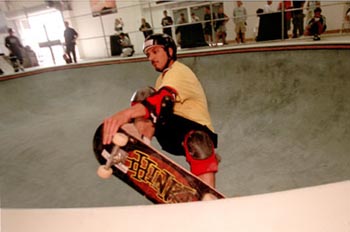![[Metroactive News&Issues]](/gifs/news468.gif)
[ San Jose | Metroactive Central | Archives ]
 Ollie Together Now New Vans skatepark opens to gleeful crowd By Chantal Lamers FORGET EVERYTHING you knew about suburban shopping malls. Now imagine unshaven and tattoo-clad twentysomethings, teenagers with fading dyed-green hair, and hordes of 7- and 8-year-old boys straggling behind their mothers--all holding skateboards under their forearms. Well, except for the mothers. It's not the typical Silicon Valley shopping crowd that's clogging up the roads into Milpitas' Great Mall. Nope. It's skateboarders--young and old--headed toward the largest, spankin' new, skatepark in the United States. The 60,000-square-foot Vans skatepark made its debut June 22, marking it the fifth indoor-mall skatepark the skate-shoe company has built in the country. A big crowd came to dig the new park--even Milpitas Mayor Henry Manayan cruised around for a few hours. The smell of freshly cut wood still scented the air and it seemed the cement in the pools had hardly dried before the first skate session began. The park is made up of three cement bowls: a professional pool with a 5-foot-deep square shallow end that drops to a 12-foot-deep round end; a peewee pool with a 3-foot-deep rectangular shallow end that drops to a 5-foot Mickey Mouse-eared deep end; and a replica of the Winchester washboard bowl. Architect Richard Rengel says the Winchester washboard is unique to the Milpitas skatepark. Vans-sponsored pro-skater and long-time Milpitas native Steve Caballero helped design the skatepark and grew up skating a washboard pool when he was just a little skatin' tike. Caballero insisted Vans build the costly washboard, several feet of cement bumps that dip into a larger pool, Rengel said. The four featured ramps include a 40-foot-wide competition half pipe; 48-foot-wide mini-ramp with a slight hip and bowl; 5,000-plus-square-foot peewee street course; and 15,000-plus-square-foot intermediate and professional street course complete with banks, ramps, ledges and rails. All that for the low-low cost of about $2 million, says Rengel. And Rengel estimates over the next two weeks the outdoor portion of the park will be finished off. It'll include dirt ramps for BMX bikers and more skating ramps. Caballero, like dozens of kids now pushing their 20s and 30s, grew up learning the ropes of the sport at skateparks. Vans-sponsored skater Salman Agan, 27, said skaters who grew up in the '70s and '80s were part of a cement-bowl era. But the whiplash of liability and potential lawsuits led to nothing but a bunch of bulldozed skateparks in the South Bay, Agan said. The lack of skateparks left skaters few choices: homemade half-pipes in the driveway, downtown street corners or mom and pop's drained swimming pool. Agan said it's why most of the older guys are hanging out around the cement bowls. He says the bowls offer a lot more variety than ramps to experienced skaters. Skaters can only go back and forth on a half-pipe--but the corners of a cement bowl make each ride different. Vans avoids that once-plaguing liability issue by making skaters sign a waiver before they go beyond the metal fence that encompasses the bowls and ramps. Parents and guardians sign for kids under 18. And everyone's required to wear a helmet and knee and elbow pads. Meanwhile, dozens of the "cement bowl era" skaters stand around the edge of the bowl. They whistle and yelp each other on. Most, if not all, have one foot on the end of their board and the tip of their boards already over the edge of the bowl, making them ready for sudden takeoff. Aaron Harrison, a 25-year-old Vans-sponsored skater, says it's called a snake session. Skating etiquette says that when the skater inside the bowl falls, whoever gets inside the quickest is going next, Harrision says. Before the fallen skater even gets out of the bowl, another skater has already swooped down the side of the bowl. Harrison says he'll probably skate the new park three days a week. "It was built by a skater," Harrison says. "Which makes a big difference. When you go to a skatepark built by a non-skater you can really tell." And if you're not into skating there's a viewing area in the park that includes cozy purple couches, fluorescent-lit air hockey tables, pinball machines, a skate shop and enough Mountain Dew and Pepsi vending machines to caffeinate an entire suburban high school. There's no doubt Vans will make up its $2 mil investment in a split second. Two-hour sessions range from $7 to $9 for members and $11 to $14 for non-members. The required gear (helmet, knee and elbow pads) can be rented for $5. No, it's not exactly free wheeling. But it's a bargain compared to the $76 fine skaters in downtown San Jose get slapped with if police catch up with them. [ San Jose | Metroactive Central | Archives ]
|
From the June 29-July 5, 2000 issue of Metro, Silicon Valley's Weekly Newspaper.
Copyright © 2000 Metro Publishing Inc. Metroactive is affiliated with the Boulevards Network.
For more information about the San Jose/Silicon Valley area, visit sanjose.com.